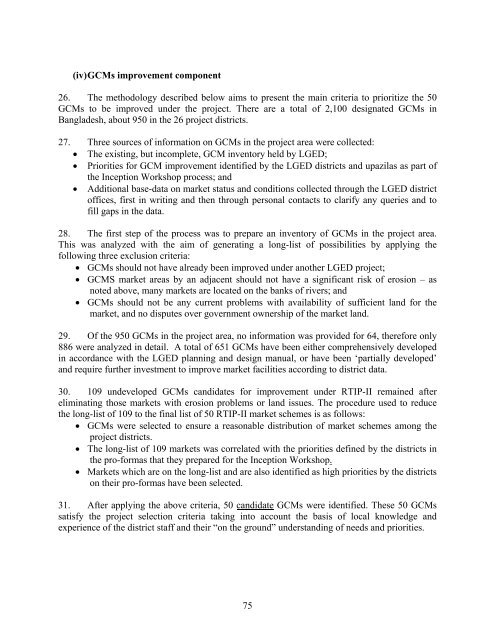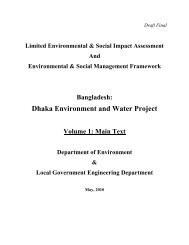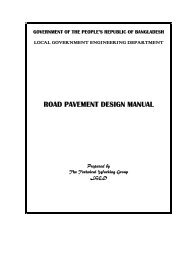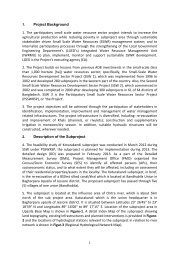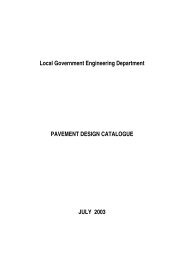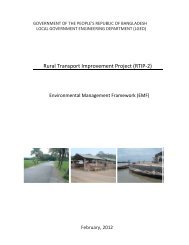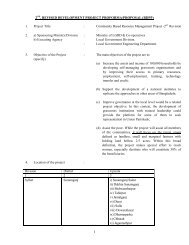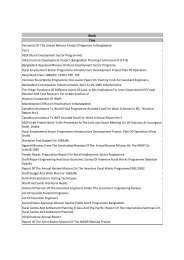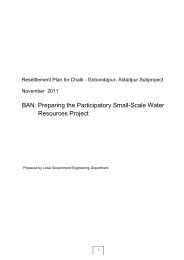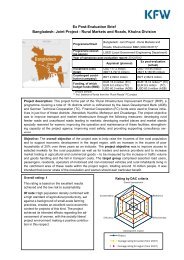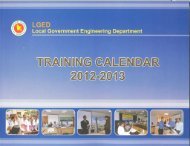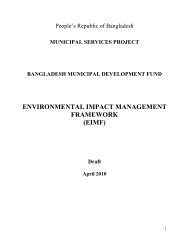PAD - LGED
PAD - LGED
PAD - LGED
You also want an ePaper? Increase the reach of your titles
YUMPU automatically turns print PDFs into web optimized ePapers that Google loves.
(iv) GCMs improvement component<br />
26. The methodology described below aims to present the main criteria to prioritize the 50<br />
GCMs to be improved under the project. There are a total of 2,100 designated GCMs in<br />
Bangladesh, about 950 in the 26 project districts.<br />
27. Three sources of information on GCMs in the project area were collected:<br />
• The existing, but incomplete, GCM inventory held by <strong>LGED</strong>;<br />
• Priorities for GCM improvement identified by the <strong>LGED</strong> districts and upazilas as part of<br />
the Inception Workshop process; and<br />
• Additional base-data on market status and conditions collected through the <strong>LGED</strong> district<br />
offices, first in writing and then through personal contacts to clarify any queries and to<br />
fill gaps in the data.<br />
28. The first step of the process was to prepare an inventory of GCMs in the project area.<br />
This was analyzed with the aim of generating a long-list of possibilities by applying the<br />
following three exclusion criteria:<br />
• GCMs should not have already been improved under another <strong>LGED</strong> project;<br />
• GCMS market areas by an adjacent should not have a significant risk of erosion – as<br />
noted above, many markets are located on the banks of rivers; and<br />
• GCMs should not be any current problems with availability of sufficient land for the<br />
market, and no disputes over government ownership of the market land.<br />
29. Of the 950 GCMs in the project area, no information was provided for 64, therefore only<br />
886 were analyzed in detail. A total of 651 GCMs have been either comprehensively developed<br />
in accordance with the <strong>LGED</strong> planning and design manual, or have been ‘partially developed’<br />
and require further investment to improve market facilities according to district data.<br />
30. 109 undeveloped GCMs candidates for improvement under RTIP-II remained after<br />
eliminating those markets with erosion problems or land issues. The procedure used to reduce<br />
the long-list of 109 to the final list of 50 RTIP-II market schemes is as follows:<br />
• GCMs were selected to ensure a reasonable distribution of market schemes among the<br />
project districts.<br />
• The long-list of 109 markets was correlated with the priorities defined by the districts in<br />
the pro-formas that they prepared for the Inception Workshop.<br />
• Markets which are on the long-list and are also identified as high priorities by the districts<br />
on their pro-formas have been selected.<br />
31. After applying the above criteria, 50 candidate GCMs were identified. These 50 GCMs<br />
satisfy the project selection criteria taking into account the basis of local knowledge and<br />
experience of the district staff and their “on the ground” understanding of needs and priorities.<br />
75


